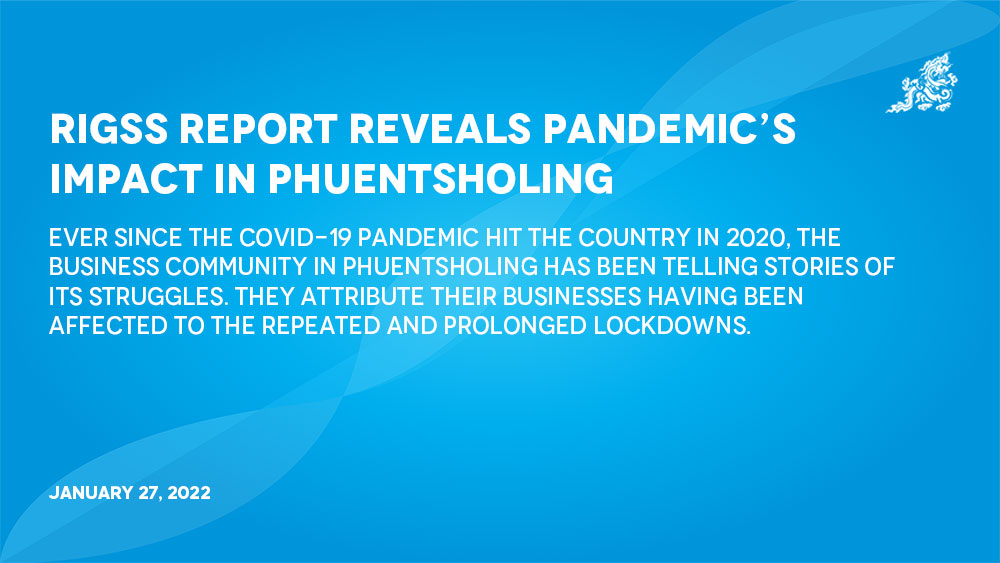Rajesh Rai | Phuentsholing
Ever since the Covid-19 pandemic hit the country in 2020, the business community in Phuentsholing has been telling stories of its struggles. They attribute their businesses having been affected to the repeated and prolonged lockdowns.
A Royal Institute for Governance and Strategic Studies (RIGSS) report called “Comprehensive Household Census of Phuentsholing Thromde and Peri-urban Areas 2021 (2021 CHCP)” has now revealed the plight in facts and figures.
RIGSS initiated the 2021 CHCP to build a comprehensive household database for the residents of Phuentsholing Thromde (PT) and adjacent peri-urban areas, in collaboration with Chhukha Dzongkhag Administration and Thromde.
According to the 2021 CHCP, there were 1,346 business enterprises operating in Phuentsholing in 2021. About 598 of them reported to be losing money in comparison to pre-pandemic times, while 536 were breaking even, and 134 were making profits.
About 53.8 percent of business enterprises (724) operated business as usual and 69 closed temporarily. About 62 business enterprises reported they would close the business within a year.
“71 planned to move their businesses to other dzongkhags.”
Meanwhile, 86.6 percent of the total 1,346 business enterprises in the town paid rent ranging from Nu 600 to Nu 500,000, according to the report. “742 business enterprises received rent waivers during the pandemic for a duration ranging from one to 21 months.”
It said: “96.7 percent of business enterprises were worried about a possible Covid-19 wave or lockdown and its long-term implication on their businesses.”
The 2021 CHCP further revealed that 524 started their business through savings and 327 through loans from financial institutions. The remaining started their business through family sponsorship, financial aid from family and friends, and inheritance.
The “others” comprised financial sources from agencies such as the Bhutan Association of Women Entrepreneurs (BAOWE) and soft loans from private companies.
Overall, 863 business owners of the total 1,346 had no standing loans for their business operation. About 384 had loans for their business, out of which 203 were paying their monthly installments and 166 were not.
Out of the 1,346 business enterprises, 605 had employees before the pandemic. During the census, only 550 had employees. “The number of employees has decreased from 4,319 (before the pandemic) to 2,818, suggesting that 1,501 individuals lost their jobs from business enterprises in Phuentsholing.”
Out of these 605 business enterprises, 246 have laid off their employees, either permanently (878 employees) or temporarily (264 employees). There were 359 business enterprises that did not lay off their employees, out of which 216 paid full salaries to their employees during the lockdowns.
A total of 706 business enterprises also reported “not being able to pay rent” as the most difficult financial problem during the pandemic, while 133 had difficulty meeting payments for supplies.
“107 enterprises faced difficulties with repaying loans and another 7.9 percent had difficulties paying salaries and wages to their employees. There were 101 business owners who reported having faced financial challenges due to increased cost of transportation,” the report said.
A businessman, Namgay, said the 2021 CHCP findings would reveal the real situation in Phuentsholing.
“In my case, I didn’t make a profit. It was a loss. The situation is bad with repeated lockdowns,” he said.
Namgay said the government has to either help the business community in Phuentsholing with low-interest or interest-free loans, or make the environment friendly enough for operating businesses.
“We are not looking to profit like we did before. We are at least looking for sustainability.”
The 2021 CHCP also highlights key findings on employment and the financial status of people in Phuentsholing during the pandemic time.
The unemployment rate of Phuentsholing is 4.8 percent, with 3.3 percent for males and 7.4 percent for females. The youth unemployment rate is 15.6 percent.
“Overall, 590 persons (mostly in the age group of 20-39) were laid off due to the pandemic.”
The report says there were 16,144 persons aged 15 and above. The average monthly individual income was Nu 19,720 pre-pandemic and Nu 13,554 during the census. It was found that the individual monthly income of 10,588 persons was less than the average monthly income.
Also, 1,535 individuals were beneficiaries of the Druk Gyalpo’s Relief Kidu, and 2,372 individuals received the Lockdown Kidu. A total of 3,375 individuals reported having loans, out of which 974 were not paying their monthly installments.


